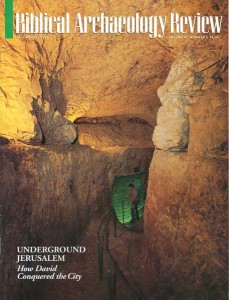Biblical Archaeology Review, July/August 1994
Special Section
How They Met: Geology Solves Long-Standing Mystery of Hezekiah’s Tunnelers
Waterworks underlying the City of David, the oldest inhabited part of Jerusalem, have two aspects that have long puzzled Biblical scholars and archaeologists. The first is whether David’s general, Joab, captured Jerusalem from the Jebusites by entering the city through an underground passage, or perhaps a water...Read more ›
Up the Waterspout: How David’s General Joab Got Inside Jerusalem
If we want to understand how King David captured Jerusalem, at least as the capture is depicted in 2 Samuel 5, we must first understand the meaning of the Hebrew word tsinnor. Geology can tell us what may have happened, as Dan Gill convincingly...Read more ›
Siloam Inscription Memorializes Engineering Achievement
Dan Gill’s new understanding of Jerusalem’s underground water installations, including Hezekiah’s famous tunnel, raises once more the question of the significance of the monumental inscription found in the tunnel recording the meeting of the two teams of tunnelers digging from opposite directions. This inscription is not the...Read more ›
Features
Israeli Court Finds Muslim Council Destroyed Ancient Remains on Temple Mount
In a hotly contested case, Israel’s Supreme Court has held that the Waqf, the Muslim religious trust, damaged and destroyed important archaeological remains on the Temple Mount in Jerusalem.a The court nevertheless declined to issue any order against the Waqf or the government authorities, apparently because of...Read more ›
An Interview with John Strugnell
Ousted chief scroll editor makes his case
Harvard professor John Strugnell was chief editor of the official Dead Sea Scroll editorial team from 1987 until he was dismissed in late 1990, after giving an anti-Semitic interview to Israeli journalist Avi Katzman, in Ha’aretz, November 9, 1990, and “Chief Dead Sea Scroll Editor Denounces Judaism,...Read more ›
Yigael Yadin: “Hoarder and Monopolist”
Yigael Yadin distinguished himself in many roles—as a general, as an archaeologist, as a historian, as a scrollster and as a politician. On his performance of these roles, save that of scrollster, I have little information to add or ability to judge. For instance, I cannot assess...Read more ›
“House of David” Built on Sand: The Sins of the Biblical Maximizers
A recent BAR article trumpets the discovery of a new inscription found at Tel Dan that allegedly mentions the name “David” and refers to the kingdom of Judah as the “House of David.”a On this basis it is suggested that Biblical scholars ignore the theories of the...Read more ›

